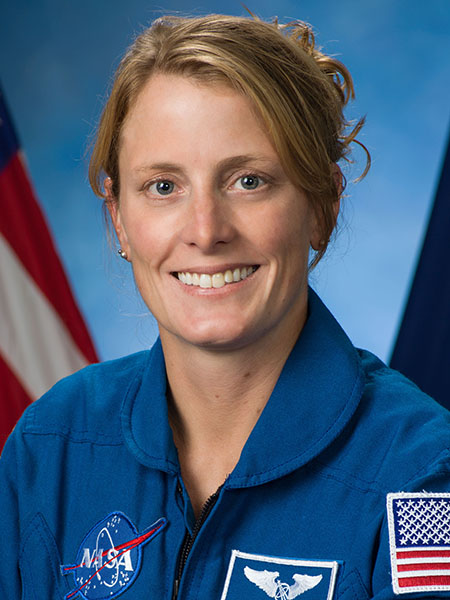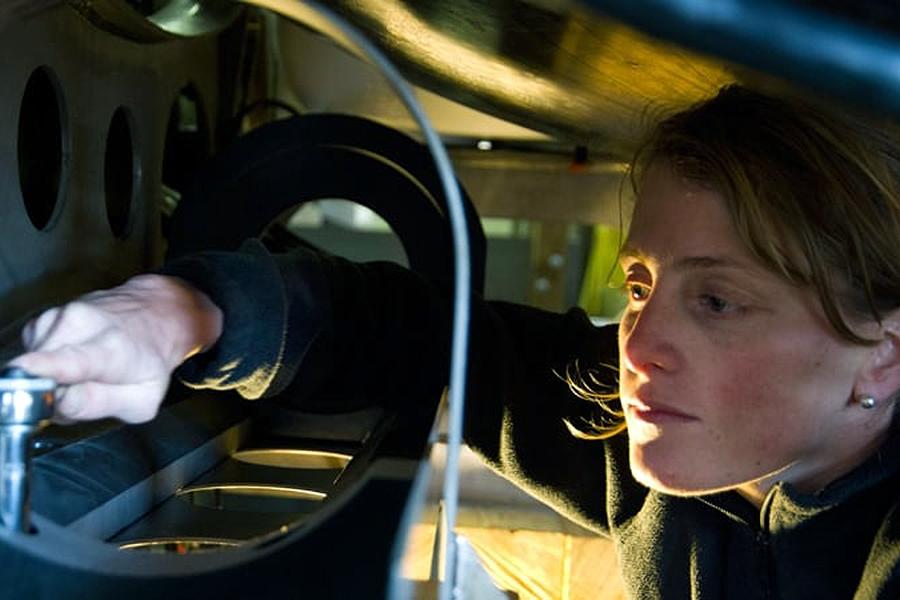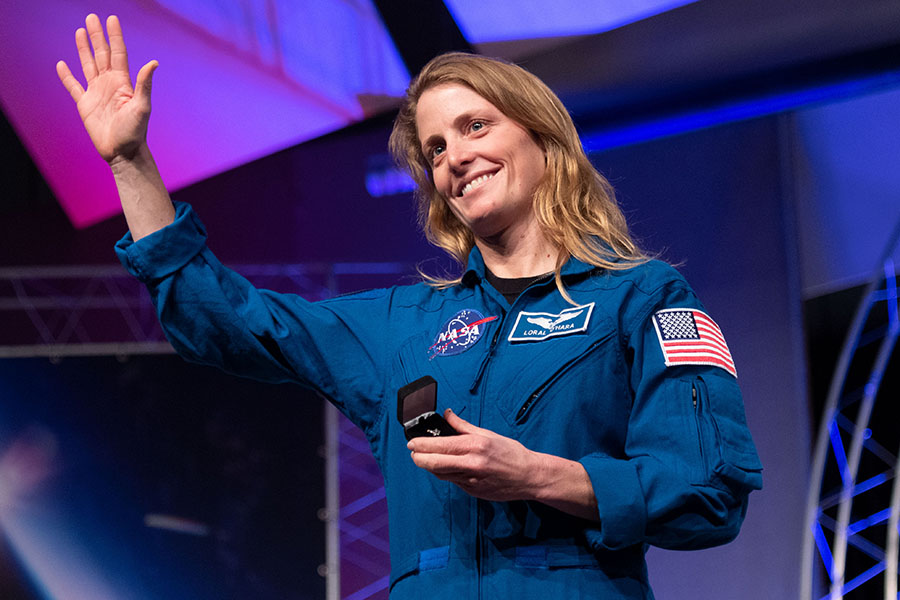Outstanding Aerospace Engineer Class of 2020: Loral O'Hara
The seeds were planted in second grade.
Literally and on a much grander scale.
Growing up in Sugar Land, Texas, about 50 miles from NASA’s Johnson Space Center, Loral O’Hara naturally was enchanted with space exploration. But it wasn’t until she participated in a school experiment that grew tomato plants from seeds that had flown on the Space Shuttle that her curiosity and excitement truly were ignited.

And that was it. The 8-year-old knew what she wanted: To explore.
The more she learned about NASA, the space program and astronauts, the more the vision solidified. She soaked up all the information she could on class field trips to JSC, and in high school, she attended several public debriefings of NASA space shuttle crews and even met the first female shuttle commander, Eileen Collins.
O’Hara, simply, was in awe of it all. And that resulted in resolute focus. Nearly every decision she made from the time she was 8 until her early 20s, even the hobbies she adopted, were meticulously chosen with one goal in mind: “What do I need to do to be an astronaut?”
By the time O’Hara realized there was no guaranteed formula for being selected to the astronaut corps, she’d taken sage advice to pursue things she was interested in, knowing there was a lot of important work to be done, not only as part of the corps. Still, she never really relinquished that dream, just tweaked the emphasis of the approach.
She dove into her adventurer tendencies, intent on exploring and understanding as many of the most remote and extreme environments on Earth that she could, whether that be caving in tight spaces, scuba diving in the depths, camper-vanning across the most barren desert in the world or diving a mile deep in a tightly packed submersible.
Those interests, and the skills garnered through each experience, ultimately helped build the ideal package to secure O’Hara’s dream.
She was selected as part of the 2017 astronaut class. After two intense years of training, she graduated from the astronaut candidate program in 2020.
“I definitely recognize that it’s both a big accomplishment in and of itself,” O’Hara said about becoming an astronaut, “but then also since it was a childhood dream to realize it, it’s not always common and that’s also a big accomplishment in and of itself, to hold onto something for that long. It’s interesting because in the astronaut corps that is true for some people and not the others. Some people are here because they have been dreaming it about their whole life, like me, and others were exposed to it at a later age.”
And this is only the beginning.
O’Hara is enjoying the gig as she awaits her first spaceflight assignment, getting another chance to explore a new environment, in Russia. She’ll take a brief break from job responsibilities soon, though, to acknowledge another accomplishment.
O’Hara will be honored April 12 in a virtual ceremony as an Outstanding Aerospace Engineer, the highest alumni honor bestowed by the School of Aeronautics and Astronautics.
“Overarching, it’s just a huge honor, especially when I look at the people who have been selected in the past and people who are selected this year. It’s an incredible honor,” said O’Hara, who obtained her master’s degree from AAE in 2009. “In general, I feel very fortunate to be a part of the Purdue community, both then and now. So it’s pretty humbling to get nominated for and receive this award.”
It’s been an exciting and rewarding journey to this point.
By high school, O’Hara knew she needed a technical degree to become an astronaut, but she wasn’t exactly sure which avenue to pursue. Her parents sealed the path on O’Hara’s 16th birthday: Their gift was a DiscoveryFlight in a Cessna.
“I had been interested in flying and airplanes for a long time, so that kind of kicked me in the direction of studying aerospace engineering in undergrad,” she said.
O’Hara attended the University of Kansas for a bachelor’s degree in a program that was aircraft-design focused. While at Kansas, she also got her first career exposure to NASA, spending a summer internship at the Jet Propulsion Lab in California and another at Goddard Space Flight Center as part of the NASA Academy.
At the same time, the commercial space industry started emerging. That sparked O’Hara’s interest, in rockets specifically. After graduating, she joined a space start-up company. At Rocketplane Limited in Oklahoma, the company was working on putting a rocket engine in a business jet-sized aircraft to send customers to suborbital space. While she was there, O’Hara got involved with the rocket propulsion system for the vehicle and decided she wanted to study propulsion and go to grad school.
Purdue University and its Maurice J. Zucrow Laboratories, widely recognized as the best propulsion test facility at a university in the country, was the natural choice.
The opportunity to do hands-on testing was a draw, and O’Hara also quickly got connected with one of the country’s preeminent experts in rocket propulsion.
On a recruiting trip to Purdue, O’Hara had a quiet confidence AAE Professor William Anderson hadn’t quite seen before. She sat down at his table, probably because of her propulsion interest, and flatly told him she would be an astronaut someday. As a professor in AAE for nearly 20 years at that point, Anderson had heard such a statement from a student before, but this felt different. It was framed less as a career goal and more a definitive statement, without a hint of arrogance.
Anderson eagerly welcomed O’Hara as a direct-Ph.D. student, though after one year, she ended up switching to a master’s track.
“I wasn’t sure I wanted to be in the research community, necessarily. I kind of missed working on programs. Ironically, I ended up in a research field, which is not lost on me,” O’Hara said with a laugh. “At the time, I thought I wanted to be working at a company like SpaceX or Blue Origin, one of those start-up companies back then. So I decided I wasn’t going to get a Ph.D. at that time and decided to go for the master’s instead.”
O’Hara was in Anderson’s combustion instability research group, working on combustion instability in liquid rocket engines. He paired O’Hara with a Ph.D. student Yen Yu, and most of O’Hara’s graduate school work was supporting Yu in the lab. (Yu, now Matsutomi, followed a different path but ended up in the same place as O’Hara: They’re both in the OAE Class of 2020.)
O’Hara didn’t quite realize at the time how difficult combustion instability work would be. She quickly found out it was a significant challenge in new rocket engine designs, and one that wasn’t understood well. But it was interesting work, and any project led by Anderson was one she was eager to tackle.
“For me, the highlight was I really enjoyed working with Bill,” O’Hara said. “He challenged me a lot, both personally and professionally. I learned a lot from working with him, both in the technical combustion instability work we were doing and also just how to be a good researcher, how to methodically approach a research problem and develop the question you want to ask, design an experiment and document and communicate those results, that whole process. I don’t think I appreciated it as much at the time, but I ended up really using those skills later on in my career.”
While she was at Purdue, O’Hara started to think less about the boxes she thought she needed to check to become an astronaut and more about the skills and the qualities of a true explorer. She still loved flying and rockets, but she just as easily could be enticed by field work in unknown territories.
So when she heard from another graduate student at Purdue about an opportunity to work in Antarctica as a research associate, her interest was piqued. At that same time, her sister Caroline was working on a master’s in geology from Penn State and spent summers hiking Iceland, studying faults. O’Hara, an adventurer at heart, felt a nudge to travel and do field work, too. Antarctica would allow her the ultimate expression to explore an extreme environment.
So O’Hara veered from the path that’d seemed so right for so long, that single-mindedness on space exploration, and applied for the research associate gig. She landed it, as an alternate. That “alternate” label meant an offer the next year, so O’Hara had to find a job in the interim.
Caroline had a friend who worked at Woods Hole Oceanographic Institution, a non-profit dedicated to advancing the knowledge of the ocean through science, engineering and education, and thought it could satisfy O’Hara’s exploratory inclinations. O’Hara found a position there as a mechanical engineer to design, build and test equipment and hardware. It appealed to her.
“I had gotten a taste of that at Purdue because I did a design, build, test class I took from Dr. Anderson. I got to design with a group of students, we designed and built and tested an experiment, so I got to do a little bit of hardware design, and I really enjoyed the whole design process, modeling parts and working with the machine shop, basic part design,” she said. “I saw that (WHOI) job posting, and it was kind of perfect.”
O’Hara was only intending to be at Woods Hole for a year, as a stop-gap to traversing Antarctica.

Soon after she arrived, she was assigned work on an upgrade to the human-occupied research submersible Alvin. She liked working on bigger projects for manned vehicles, so she knew this project would be up her alley.
“And it’d be really cool to dive in a sub,” she said with a laugh.
So instead of taking the job in Antarctica, she stayed at Woods Hole. Ultimately, she participated in 11 research cruises aboard research vessels, including one in the 6-foot, 11-inch diameter sphere inside Alvin. She was wowed to realize that she was experiencing the ideal mix of engineering and operations, and she liked it.
She saw the whole Alvin project through — it lasted four years. She considered leaving WHOI several times to go back into aerospace, but, in the end, “I really loved working there.”
“I liked the work I was doing. That was my trajectory, if I hadn’t come to NASA, to be a mostly operational person,” she said. “I liked the people I worked with. Got to travel all over the world and work with different scientists from all over the world. So it was cool, and it was exactly what I had been looking for.”
O’Hara also was developing skill sets at WHOI that, ultimately, amplified her application for NASA. She saw going to sea very much akin to going to a sea “of a different nature” in space, on a different kind of vehicle. Both environments and work do complex science and research in remote and very limited environments, providing the best kind of challenges.
O’Hara applied for the astronaut class a second time and third time while she was at WHOI.
The latter clicked.
Out of more than 18,000 applicants, she made the first cut of 120 to come for an in-person interview. The next cut down to 50 included a second round of in-person interviews. Then in June 2017, at the end of an 18-month-long process, she learned she was among 12 chosen for the Astronaut Candidate Class. She reported for duty in August 2017.

After two years of training that included instruction in ISS systems, spacewalk training in the Neutral Buoyancy Lab, robotics, T-38 flight training, and water and wilderness survival training, she graduated the astronaut candidate program and joined its corps in January 2020.
“My life has changed in every way possible,” she said in an interview February 2020. “Doing a job I’ve wanted to do since I was a little kid, sometimes it’s really surreal that I’m actually here working at NASA as an astronaut. Other times, it feels very similar. We’re still trying to do hard things with a great team of people and the challenges aren’t all that different.”
In some of her first work after completing the astronaut candidate program, O’Hara was crew representative to the ISS program. She interfaced with families and supported the crew on orbit in ISS program meetings. She generally coordinated between the Astronaut Office and the ISS program. She wasn’t the only person doing that, but her specific focus was the crew at that time on Space Station.
In August 2020, O’Hara started a year-long assignment in Russia serving as NASA Director of Operations-Star City, supporting crew training and operations in Russia.
“It’s really exciting right now to be in the position that myself and my classmates are in right now because there is so much activity and energy at NASA,” O’Hara said. “It feels really like our careers could go in any direction, and that’s pretty exciting.”
More on 2020 class of OAEs:
March 29: Doug Adams
March 30: Chris Clark
March 31: Darin DiTommaso
April 1: Doug Joyce
April 2: Yen Matsutomi
April 6: David Schmidt
April 7: Stevan Slijepcevic
April 8: Rhonda Walthall
